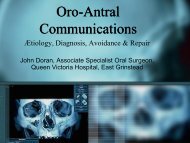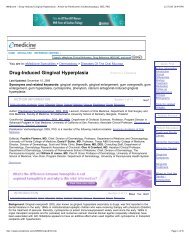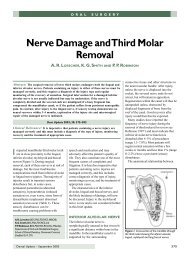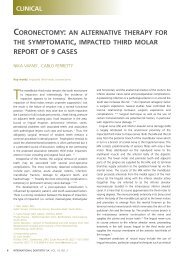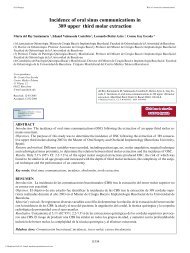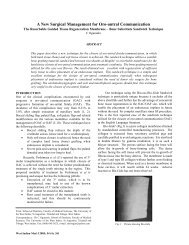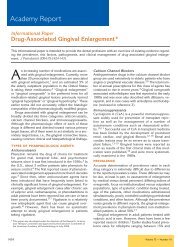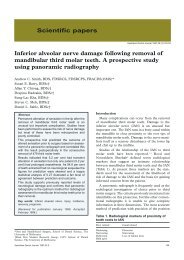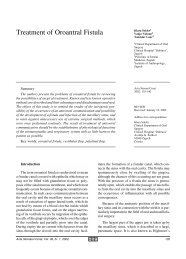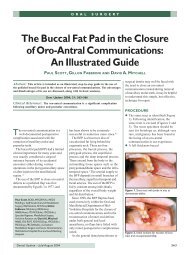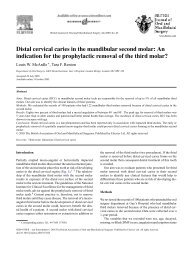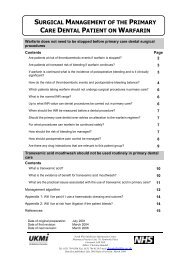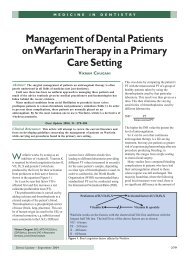Oral Surg Oral Med Oral Pathol Oral Radiol Endod 2004 - Surgical ...
Oral Surg Oral Med Oral Pathol Oral Radiol Endod 2004 - Surgical ...
Oral Surg Oral Med Oral Pathol Oral Radiol Endod 2004 - Surgical ...
You also want an ePaper? Increase the reach of your titles
YUMPU automatically turns print PDFs into web optimized ePapers that Google loves.
ORAL SURGERY ORAL MEDICINE ORAL PATHOLOGY<br />
Volume 97, Number 1<br />
Table II. Drugs that may give rise to xerostomia<br />
Drugs with anticholinergic effects<br />
Atropine and analogs (antimuscarinics)<br />
Tricyclic antidepressants<br />
Serotonin reuptake inhibitors<br />
Antihistamines<br />
Antiemetics<br />
Antipsychotics<br />
Drugs with sympathomimetic actions<br />
Decongestants<br />
Bronchodilators<br />
Appetite suppressants<br />
Amphetamines<br />
Other drugs<br />
Lithium<br />
Omeprazole<br />
Oxybutynin<br />
Disopyramide<br />
Dideoxyinosine<br />
Didanosine<br />
Diuretics<br />
Protease inhibitors<br />
Porter, Scully, and Hegarty 29<br />
mL/min. In human beings, saliva is always hypotonic to<br />
plasma, with sodium and chloride ion concentrations<br />
being less than those of plasma. The greater the secretory<br />
flow rate, the higher the tonicity of the saliva.<br />
Salivary gland secretion is mainly under autonomic<br />
nervous control, but various hormones may also modulate<br />
salivary composition. Secretion appears to be<br />
dependent on several modulatory influences that act<br />
either through a cyclic adenosine monophosphate–dependent<br />
or a calcium-dependent pathway.<br />
Saliva consists of 2 components that are secreted by<br />
independent mechanisms: First, a fluid component that<br />
includes ions, produced mainly by parasympathetic<br />
stimulation; second, a protein component arising from<br />
secretory vesicles in acini and released mainly in response<br />
to sympathetic stimulation. Excitation of either<br />
sympathetic or parasympathetic nerves to the salivary<br />
glands stimulates salivary secretion, but the effects of<br />
the parasympathetic nerves are stronger and longerlasting.<br />
The ducts of salivary glands respond to both cholinergic<br />
and adrenergic agonists by increasing the<br />
rates of secretion of potassium (K ) and bicarbonate<br />
(HCO 3 ). In serous acinar cells, acetylcholine, norepinephrine,<br />
substance P, and vasoactive intestinal<br />
polypeptide are released by specific nerve terminals<br />
and increase the secretion of salivary amylase and<br />
the flow of saliva. Acetylcholine, substance P, and<br />
norepinephrine acting on -receptors increase the<br />
concentration of calcium ions in the serous acinar<br />
cells, resulting in profuse secretion with a lower<br />
concentration of amylase. In contrast, norepinephrine<br />
acting on -receptors and vasoactive intestinal<br />
polypeptide elevates the cyclic adenosine monophosphate<br />
concentration in acinar cells, eliciting a secretion<br />
that is rich in amylase. 2<br />
Thus, parasympathetic stimulation produces copious<br />
saliva of low protein concentration, whereas sympathetic<br />
stimulation produces little saliva but with high<br />
protein concentration, which may give a sensation of<br />
dryness. 3<br />
THE ETIOLOGY OF LONG-STANDING<br />
XEROSTOMIA<br />
Long-standing xerostomia (dry mouth) has many<br />
causes, 4 but drug-induced xerostomia is the most common<br />
type.<br />
Iatrogenic<br />
Drugs. Xerostomia is the most common adverse<br />
drug-related effect in the oral cavity. To date, xerostomia<br />
has been associated with more than 500 medications.<br />
In addition, the synergistic effects of medications<br />
have been recognized and are increasingly<br />
common in elderly patients taking multiple medications.<br />
5 Dry mouth is a common problem for many<br />
elderly persons. 6<br />
The principal mechanism of drug-induced xerostomia<br />
is an anticholinergic or sympathomimetic action;<br />
thus, the drugs most commonly implicated in xerostomia<br />
include tricyclic antidepressants, antipsychotics,<br />
benzodiazepines, atropinics, -blockers, and antihistamines.<br />
Therefore, xerostomia is common in<br />
patients treated for hypertensive or mental illness. A<br />
wide range of other drugs can give rise to oral<br />
dryness (Table II). 4 Often promoted as having fewer<br />
anticholinergic actions than the tricyclics, the serotonin<br />
reuptake inhibitors also cause some degree of<br />
xerostomia. Some other newer therapies, including<br />
omeprazole, anti– human immunodeficiency virus<br />
(HIV) protease inhibitors, the nucleoside analog HIV<br />
reverse transcriptase inhibitor didanosine, trospium<br />
chloride, elliptinium, tramadol, and new-generation<br />
antihistamines may all cause drug-induced<br />
xerostomia. 5-16<br />
Some drugs—such as hydralazine, busulfan, quinidine<br />
sulfate, and thiabendazole—can give rise to primary<br />
Sjögren’s syndrome–like disease; however, this<br />
clinical disease can be transient. In addition, affected<br />
patients may not have high levels of immunologic<br />
markers of Sjögren’s syndrome; thus, it seems unlikely<br />
that this is true Sjögren’s syndrome. 17<br />
Therefore, with drug-associated xerostomia, there is<br />
usually a fairly close temporal relationship between the<br />
commencement of medication or increasing the dose<br />
and experiencing the dry mouth. However, the cause



